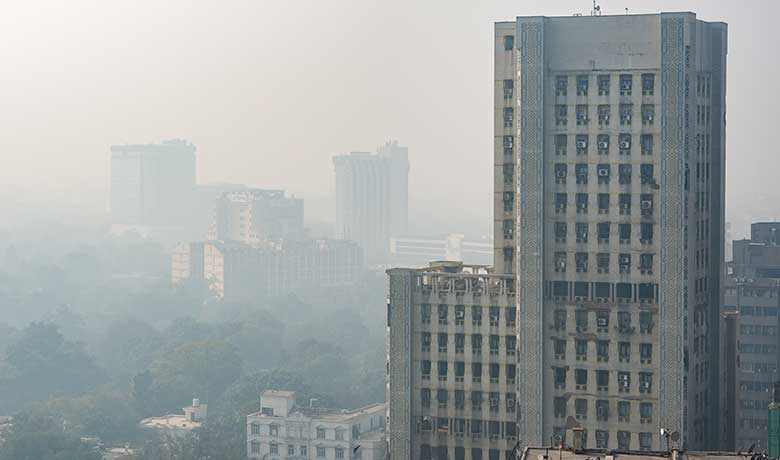Poor air quality directly affects our health. This increases the risk of respiratory issues, heart problems, and many other serious diseases. High-level air pollution can cause many adverse health consequences. This increases the risk of respiratory infections, heart disease, and lung cancer. Those who are already ill are the most affected. Children, the elderly, and poor people are more prone to it. When the particulate matter is 2.5, it tends to enter deeper into the lung passages
 Priyanka Saurabh
Priyanka Saurabh

Air pollution has a huge impact on human health in India. It is the second largest risk factor for disease and the economic cost of air pollution is estimated to exceed US$150 billion annually. Major sources of air pollution in India include vehicular emissions, power generation, industrial waste, biomass combustion for cooking, construction areas, and crop burning. Black carbon is a component of soot resulting from the incomplete combustion of fossil fuels, biofuels, and biomass. Chemically, it is a component of fine particulate matter (PM≤ 2.5 µm). It is a type of aerosol emitted from gas and diesel engines, coal-fired power plants, and other sources that burn fossil fuels.
Particles less than 2.5 micrometers in diameter (PM2.5) pose the greatest health risk. Because of their small size (about 1/30th of the average width of a human hair), fine particles can penetrate deep into the lungs. Particulate matter is particles found in the air, including dust, dirt, soot, smoke, and Fluid drops are also included. Particulate matter is typically emitted from sources such as diesel vehicles and coal-fired power plants. Particles less than 10 micrometers in diameter (PM10) are of health concern. These can be inhaled and accumulate in the respiratory system.
Black carbon is produced both naturally and anthropogenically (outside human activities) from the incomplete combustion of fossil fuels, biomass, etc. Major sources are emissions from diesel engines, cooking stoves, wood burning, and forest fires. Domestic cooking and heating account for 58% of global black carbon emissions. The developing world contributes about 88% of black carbon emissions as a result of open biomass burning and residential solid fuel combustion.
According to the news published by WHO in Geneva (Switzerland), as the world becomes hotter and more crowded, the machines we use are emitting more and more bad emissions. Half the world doesn’t even have access to clean fuel or stoves, or lamps. The air we breathe is getting dangerously polluted. About 7 million people die every year due to breathing polluted air.

e-mail: infocom.krc@gmail.com
Know More | Apply Here
Black carbon particles are a major component of particulate matter in the atmosphere, which can adversely affect air quality. Inhaling these particles can cause respiratory problems, heart disease, and other health problems. Black carbon particles can penetrate deep into the lungs, causing inflammation and irritation. It can aggravate pre-existing respiratory conditions like asthma and bronchitis.
Exposure to black carbon also increases the risk of heart disease and stroke. Its relation to air pollution and the respiratory system is quite clear. Air pollution is known to affect the nervous system as well. When particulate matter enters the nasal cavity, it causes inflammation.
This makes the situation worse. The World Health Organization states that the health risks due to air pollution are greatly increased, and particles can cause irritation and inflammation in the nose. It can also cause a runny nose. Air pollution may also be associated with lung damage and impairing lung function.
Air pollution has an inflammatory effect on the heart, it can increase blood pressure and aggravate pre-existing heart disease. Long-term exposure to polluted air significantly increases the risk of death. People prone to heart disease are at higher risk.
Black carbon aerosols absorb sunlight and heat the atmosphere, contributing to global warming. They also darken snow and ice, causing it to melt faster, which could lead to sea level rise and other effects of climate change. Regional Air Quality and Climate Effects The effects of black carbon aerosols are not uniform and vary regionally. For example, in South Asia, black carbon contributes significantly to air pollution and has been linked to changes in the monsoon system with effects on regional climate.

Research Scholar in Political Science,
Poetess, freelance journalist, and columnist,
Ubba Bhavan, Aryanagar, Hisar (Haryana)
Measures can be taken to reduce the emission of black carbon such as promoting the use of clean energy sources and encouraging the adoption of clean energy sources such as solar and wind energy to reduce the amount of black carbon released from burning fossil fuels can be reduced. Improving transport systems, encouraging the use of electric vehicles, and investing in public transport systems can help reduce emissions from transport, a major source of black carbon.
Reduce open burning of solid fuels Open burning of solid fuels such as wood, charcoal, and agricultural waste can reduce black carbon emissions. Implementing emission control technologies, installing filters, and other emission control technologies on industrial facilities and vehicles can reduce the amount of black carbon released into the atmosphere.
Investing in research and development of new technologies and practices to reduce black carbon emissions can help identify new ways to reduce its impacts.
Educating the public on the negative effects of black carbon emissions through public awareness and promoting more sustainable lifestyle choices can help reduce emissions and mitigate their effects. Overall, reducing black carbon emissions requires a multi-pronged approach involving a combination of policy measures, technological advances, and behavioral changes.
To solve this problem, we cannot focus only on the government, for this our mutual partnership is important. Every citizen should play a responsible role in reducing the environmental pollution. He also said that we should coordinate for better disaster management.


